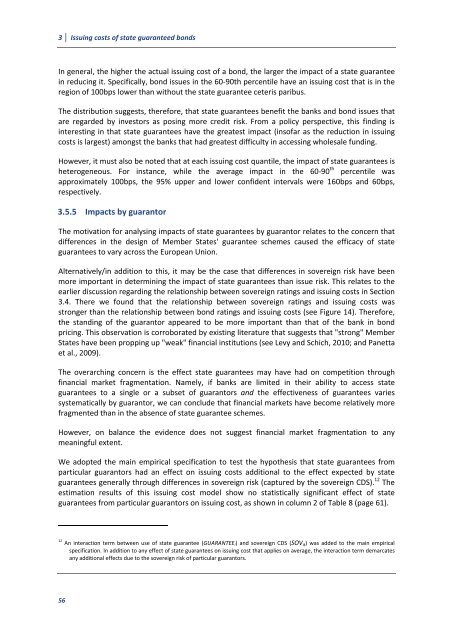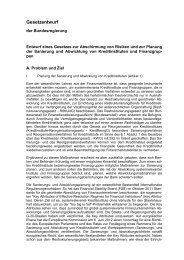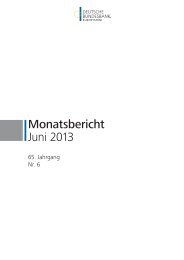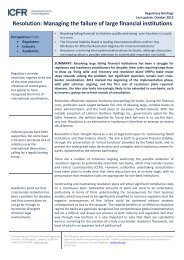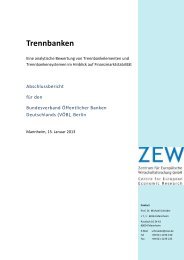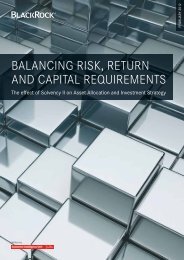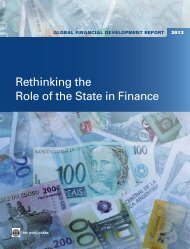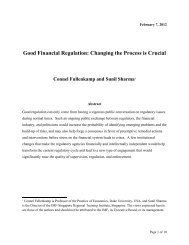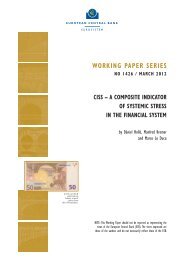3 Issuing costs of state guaranteed bonds - Financial Risk and ...
3 Issuing costs of state guaranteed bonds - Financial Risk and ...
3 Issuing costs of state guaranteed bonds - Financial Risk and ...
You also want an ePaper? Increase the reach of your titles
YUMPU automatically turns print PDFs into web optimized ePapers that Google loves.
3 <strong>Issuing</strong> <strong>costs</strong> <strong>of</strong> <strong>state</strong> <strong>guaranteed</strong> <strong>bonds</strong><br />
In general, the higher the actual issuing cost <strong>of</strong> a bond, the larger the impact <strong>of</strong> a <strong>state</strong> guarantee<br />
in reducing it. Specifically, bond issues in the 60-90th percentile have an issuing cost that is in the<br />
region <strong>of</strong> 100bps lower than without the <strong>state</strong> guarantee ceteris paribus.<br />
The distribution suggests, therefore, that <strong>state</strong> guarantees benefit the banks <strong>and</strong> bond issues that<br />
are regarded by investors as posing more credit risk. From a policy perspective, this finding is<br />
interesting in that <strong>state</strong> guarantees have the greatest impact (ins<strong>of</strong>ar as the reduction in issuing<br />
<strong>costs</strong> is largest) amongst the banks that had greatest difficulty in accessing wholesale funding.<br />
However, it must also be noted that at each issuing cost quantile, the impact <strong>of</strong> <strong>state</strong> guarantees is<br />
heterogeneous. For instance, while the average impact in the 60-90 th percentile was<br />
approximately 100bps, the 95% upper <strong>and</strong> lower confident intervals were 160bps <strong>and</strong> 60bps,<br />
respectively.<br />
3.5.5 Impacts by guarantor<br />
The motivation for analysing impacts <strong>of</strong> <strong>state</strong> guarantees by guarantor relates to the concern that<br />
differences in the design <strong>of</strong> Member States' guarantee schemes caused the efficacy <strong>of</strong> <strong>state</strong><br />
guarantees to vary across the European Union.<br />
Alternatively/in addition to this, it may be the case that differences in sovereign risk have been<br />
more important in determining the impact <strong>of</strong> <strong>state</strong> guarantees than issue risk. This relates to the<br />
earlier discussion regarding the relationship between sovereign ratings <strong>and</strong> issuing <strong>costs</strong> in Section<br />
3.4. There we found that the relationship between sovereign ratings <strong>and</strong> issuing <strong>costs</strong> was<br />
stronger than the relationship between bond ratings <strong>and</strong> issuing <strong>costs</strong> (see Figure 14). Therefore,<br />
the st<strong>and</strong>ing <strong>of</strong> the guarantor appeared to be more important than that <strong>of</strong> the bank in bond<br />
pricing. This observation is corroborated by existing literature that suggests that "strong" Member<br />
States have been propping up "weak" financial institutions (see Levy <strong>and</strong> Schich, 2010; <strong>and</strong> Panetta<br />
et al., 2009).<br />
The overarching concern is the effect <strong>state</strong> guarantees may have had on competition through<br />
financial market fragmentation. Namely, if banks are limited in their ability to access <strong>state</strong><br />
guarantees to a single or a subset <strong>of</strong> guarantors <strong>and</strong> the effectiveness <strong>of</strong> guarantees varies<br />
systematically by guarantor, we can conclude that financial markets have become relatively more<br />
fragmented than in the absence <strong>of</strong> <strong>state</strong> guarantee schemes.<br />
However, on balance the evidence does not suggest financial market fragmentation to any<br />
meaningful extent.<br />
We adopted the main empirical specification to test the hypothesis that <strong>state</strong> guarantees from<br />
particular guarantors had an effect on issuing <strong>costs</strong> additional to the effect expected by <strong>state</strong><br />
guarantees generally through differences in sovereign risk (captured by the sovereign CDS). 12 The<br />
estimation results <strong>of</strong> this issuing cost model show no statistically significant effect <strong>of</strong> <strong>state</strong><br />
guarantees from particular guarantors on issuing cost, as shown in column 2 <strong>of</strong> Table 8 (page 61).<br />
12 An interaction term between use <strong>of</strong> <strong>state</strong> guarantee (GUARANTEEi) <strong>and</strong> sovereign CDS (SOVit) was added to the main empirical<br />
specification. In addition to any effect <strong>of</strong> <strong>state</strong> guarantees on issuing cost that applies on average, the interaction term demarcates<br />
any additional effects due to the sovereign risk <strong>of</strong> particular guarantors.<br />
56


